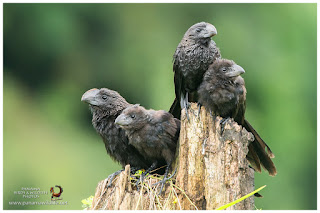The anis are the three species of
near-passerine birds in the genus Crotophaga of the
cuckoo family. In this family they are somewhat distinct, given they are
black birds. Their flight is weak and wobbly, but they run well, and usually feed on the ground.
Though the three are commonly found in Panama, this post is focused on one of them, the Smooth-billed Ani (Crotophaga ani). A species found from southern Florida, the Bahamas, the Caribbean, parts of Central America, south to western Ecuador, Brazil, and northern Argentina, in open and semi-open areas under cultivation.
 |
| Smooth-billed Anis (Crotophaga ani) - adult and juveniles |
Unlike some cuckoos, the anis are not
brood parasites, but nest communally, the cup nest being built by several pairs between 2–6 m (6-20 ft) high in a tree. A number of females lay their eggs in the nest and then share incubation and feeding. These are very gregarious species, always found in
noisy groups.
 |
| Smooth-billed Anis (Crotophaga ani) - adult and juveniles |
The claim that they will remove ticks; giving them the name “garrapateros” (tickeaters); from grazing animals has been debated. While there is no doubt that anis follow grazing animals in order to catch disturbed insects (Anis feed on termites, large insects and even lizards and frogs), and will occasionally eat fallen ticks, there is debate if they actually remove ticks from the animals' bodies.
Its vernacular name also has been the subject of conflict: in Panamanian rural areas the three species of anis were known as (the real) “talingos", a name that has been taken by another unrelated black bird, the Large-tailed Grackle also known as “chango" or “changamé”. The two smaller species of anis are also known as "tingo-tingos”, an onomatopoeia of the flight call of the Groove-billed Ani (Crotophaga sulcirostris).
 |
| Smooth-billed Ani (Crotophaga ani) |
 |
| Smooth-billed Ani (Crotophaga ani) |
The smooth-billed is larger on average than the groove-billed ani but smaller than the greater ani. The adult is mainly flat black with blueish iridescence, with a long tail, deep ridged smooth black bill (absent of huge horizontal grooves) and a brown iris. The flight is weak and wobbly, but the bird runs well and usually feeds on the ground. As other cuckoos, the two inner toes point forward and the two outer backward.
Despite this common and conspicuous species has greatly benefited from deforestation, it’s conflict with other species like the before-mentioned grackle, that also has benefited from deforestation, has been cited.
While we were in the open making these anis' portraits we also observed other species shown below:
 |
| Black-striped Sparrow (Arremonops conirostris) |
 |
| Rusty-margined Flycatcher (Myiozetetes cayanensis) |
 |
| Bat Falcon (Falco rufigularis) |










Comments
Post a Comment